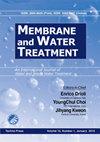低温浸没式膜生物反应器中膜污染及污泥特性研究
IF 1.1
4区 工程技术
Q4 ENGINEERING, CHEMICAL
引用次数: 1
摘要
本研究旨在研究中试规模的浸没式膜生物反应器(MBR)在低温(7摄氏度)下运行时的膜污染和污泥特性。为了阐明低温下膜污染的机理,我们研究了MBR性能与污泥(包括胞外聚合物(EPS))理化性质之间的相关性,相对疏水性(RH)和絮体尺寸。在低温条件下丝状细菌(膨胀污泥)过度生长的情况下,MBR能够稳定有效地去除化学需氧量(COD)(>90%)。另一方面,丝状膨胀的发生大大加速了膜污染,7摄氏度下丝状膨胀的膜过滤期为14天,而24摄氏度下非膨胀污泥的膜过滤时间为27天。低温条件下丝状细菌的过度生长导致EPS的释放增加,相对湿度更高,絮体尺寸更小,污泥的分形维数更低。这些因素加速了膜表面致密滤饼层的形成,与膜的跨膜压力(TMP)增加方面的性能降低相关,从而降低了膜渗透性。本文章由计算机程序翻译,如有差异,请以英文原文为准。
Membrane fouling and sludge characteristics in submerged membrane bioreactor under low temperature
This study aimed to investigate the membrane fouling and sludge characteristics in a pilot-scale submerged membrane bioreactor (MBR) operated under low temperature (7 degree Celcius) To elucidate the mechanisms of membrane fouling at low temperature, we studied the correlation between MBR performances and physicochemical properties of sludge including extracellular polymeric substance (EPS), relative hydrophobicity (RH) and floc size during long-term operation. The MBR was shown able to remove chemical oxygen demand (COD) stably and efficiently (>90 %) in the case of overgrowth of filamentous bacteria (bulking sludge) at low temperature. On the other hand, the occurrence of filamentous bulking greatly accelerated membrane fouling, as indicated by membrane filtration period of 14 days for filamentous bulking at 7 degree Celcius, in comparison with that of 27 days for non-bulking sludge at 24 degree Celcius. The overgrowth of filamentous bacteria resulting from low-temperature condition led to an increased release of EPS, higher RH, smaller floc size and lower fractal dimension of sludge. These factors accelerated the formation of compact cake layer on membrane surface in association with performance diminution in terms of increase in transmembrane pressure (TMP) of the membrane and thus the decrease in membrane permeability.
求助全文
通过发布文献求助,成功后即可免费获取论文全文。
去求助
来源期刊

Membrane Water Treatment
ENGINEERING, CHEMICAL-WATER RESOURCES
CiteScore
1.90
自引率
30.00%
发文量
0
审稿时长
>12 weeks
期刊介绍:
The Membrane and Water Treatment(MWT), An International Journal, aims at opening an access to the valuable source of technical information and providing an excellent publication channel for the global community of researchers in Membrane and Water Treatment related area. Specific emphasis of the journal may include but not limited to; the engineering and scientific aspects of understanding the basic mechanisms and applying membranes for water and waste water treatment, such as transport phenomena, surface characteristics, fouling, scaling, desalination, membrane bioreactors, water reuse, and system optimization.
 求助内容:
求助内容: 应助结果提醒方式:
应助结果提醒方式:


